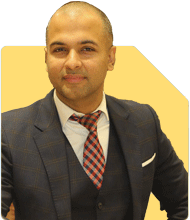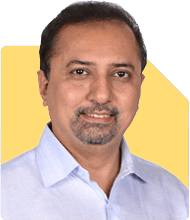Harsh Bharwani | Answer |Ask -Follow
Entrepreneurship Expert - Answered on Apr 03, 2023
As CEO and managing director, he leads the international business and employability initiatives at the computer networking institute, Jetking Infotrain Limited.
After graduating from Delhi University, Bharwani joined the family business in 2010 and set up operations in the US and Vietnam.
He has trained over three lakh students in employability, confidence and key life skills.... more

Hello Harsh, I am 33 yrs old, working as an SAP Consultant in an MNC company. I and one of my friend started one IT company in 2019 and at the same time we started one E-commerce company which we registered it in 2021 as a Pvt Ltd company. Initially, I brought a business of around 2.5L - 3L during the COVID time but most of the time we give in developing our E-commerce company. Due to this, we are unable to focus on our IT company. We have already given 3 years on our E-commerce and we have also launched 2 soaps and 2 essential oils with our own brand and manufactured from 3rd party vendor. Right now both companies are loss-making. I want your suggestion as to which company I should focus on more so that I can bring revenue and make it profitable. I want your guidance.
To make a decision about which company to focus on, you may want to consider a few things:
1. Revenue potential: Consider the revenue potential of each company. Which company has the potential to generate more revenue in the near future?
2. Market demand: Evaluate the market demand for the products/services offered by each company. Which company has a larger market demand and growth potential?
3. Your expertise: Consider your expertise and experience in both industries. Which company are you more knowledgeable about and can you bring more value to?
4. Cost and resources: Evaluate the cost and resources required to run each company. Which company requires more investment and resources?
Based on the above factors, you can decide which company to focus on. You may also want to consider the possibility of merging the two companies or scaling down one of them to focus on the other.
It is important to remember that building a successful business takes time and effort. It is not uncommon for businesses to experience losses in the early stages. Keep persevering and continue to innovate and adapt to the changing market conditions.
I hope this advice helps you make a decision about which company to focus on. Good luck!
You may like to see similar questions and answers below
Chandu Nair | Answer |Ask -Follow
VC, Angel Investing, Entrepreneurship Expert - Answered on Apr 15, 2023
Harsh Bharwani | Answer |Ask -Follow
Entrepreneurship Expert - Answered on Apr 12, 2023
Chandu Nair | Answer |Ask -Follow
VC, Angel Investing, Entrepreneurship Expert - Answered on Jun 15, 2023
Chandu Nair | Answer |Ask -Follow
VC, Angel Investing, Entrepreneurship Expert - Answered on Nov 14, 2023
Nayagam P P |10849 Answers |Ask -Follow
Career Counsellor - Answered on Sep 16, 2024
Dr Dipankar Dutta |1837 Answers |Ask -Follow
Tech Careers and Skill Development Expert - Answered on Dec 05, 2025
Dr Shyam Jamalabad |108 Answers |Ask -Follow
Dentist - Answered on Dec 05, 2025
Dr Shyam Jamalabad |108 Answers |Ask -Follow
Dentist - Answered on Dec 05, 2025
Dr Shyam Jamalabad |108 Answers |Ask -Follow
Dentist - Answered on Dec 05, 2025
Dr Dipankar Dutta |1837 Answers |Ask -Follow
Tech Careers and Skill Development Expert - Answered on Dec 05, 2025
Ulhas Joshi |280 Answers |Ask -Follow
Mutual Fund Expert - Answered on Dec 05, 2025
Dr Dipankar Dutta |1837 Answers |Ask -Follow
Tech Careers and Skill Development Expert - Answered on Dec 04, 2025
Ravi Mittal |676 Answers |Ask -Follow
Dating, Relationships Expert - Answered on Dec 04, 2025
Anu Krishna |1745 Answers |Ask -Follow
Relationships Expert, Mind Coach - Answered on Dec 04, 2025
Anu Krishna |1745 Answers |Ask -Follow
Relationships Expert, Mind Coach - Answered on Dec 04, 2025





























